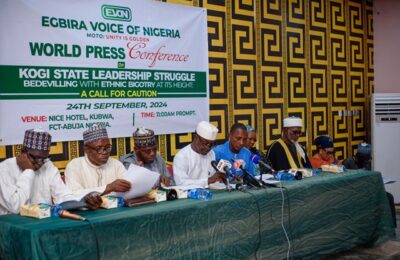State of Kogi’s IGR can surpass Lagos State in ten years if Governor Bello’s government is smart enough to take advantage of its “Center of Gravity” and invest in fiber-optic development. Scientifically, “Center of Gravity” simply means being located in the center of the country; which is a prime factor for data, voice and video traffics to travel at equilibrium speeds across the country.
In addition to aggressively pursuing fiber-optic development as a source of new revenues, Kogi State can also take advantage of her “Centerness” in the country as well as her nearness to Abuja – the City of Africa’s most powerful government.
Here is how Governor Bello can improve Kogi State IGR.
From India to Brazil and South Africa to Russia, Internet the economic currency of today and fiber-optic is synonymous to fast access. One way to solve that problem is to createFiber-To-The-Home or FTTH is now the gold standard of business and residential internet connections.
With much of the backbone of the internet deployed using fiber optic cable, it is no surprise that fiber optics are the fastest form of broadband technology.
So, with Fiber-Optic in Kogi State, local and foreign companies will automatically be attracted to relocate services to the state instead of Lagos – because lots of business data can be transferred very quickly to and from, Kogi will become the center for next generation technology such as IoT and there will be no limitation to what businesses can dream and do.

Kogi State represents the “Center of Gravity” in Nigeria and it should be able to reap the benefits financially if the governor understand the ROI and the competitive advantage it can bring to the State.
Taking advantage of Kogi State’s“Center of Gravity” could mean methodically creating a business environment where conditions are set for success and revenues in terms of corporate taxation and full employment of Kogi State citizens.
Microsoft predicted that by 2020, the combined ICT and telecom market will hit nearly $4 trillion, due to the incremental revenue generated by the Internet of Things‘ and any Nigerian State that create a good groundwork for IoT via fiber-optic development will reap the full benefits.
Without getting too technical, fiber-optic for example helps Internet Service Providers and other technology Companies expand, accelerate their Wide-Area Networks and synchronous data, video and voice traffics effortlessly.
Therefore, Kogi State Governor Bello should busy wooing and courting localInternet Service Providers such as GLO, MTN, ETISALAT to relocate or build Datacenter in the state to enable them replicate and synchronize their voice, video and data traffics due to the “Centerness” of Kogi State. The advantage of building Datacenters in a central locationinclude reliability and quality of service (QoS) compared to other WAN connectivity options.
Aside from IGR increase the Objective of Governor Bello could become positioning Kogi State as the Future of Nigeria’s technology center as in Silicon-Valley California today. Many technology companies could follow suite and start to build MPLS networks in the State.
MPLS is Multiprotocol Label Switching – a type of data-carrying technique for high-performance telecommunications networks that directs data from one network node to the next based on short path labels rather than long network addresses, avoiding complex lookups in a routing table. Those type of MPLS work better if the originating date source is in the center of the country.
With Fiber-Optic Kogi State’s state Internally Generated Revenue (IGR) could quadruple in ten years resulting in full employment of her citizens and Lagos State jealously looking at her rear-end.
From the ultra-fast transatlantic fiber lines that connect the Americas to Europe and vice versa couples with the underwater fiber-optic of Main One Cable in Lagos that connects Africa to the rest of the world, to the data hubs that connect your home computer and or your telephone handset to the internet, everything comes back to fiber that Kogi State can benefit.
How does it work? Well, at a fundamental level, fiber optic communication works by sending small binary transmissions of light down a fiber optic wire. Then, at each end of the fiber optic infrastructure there is a computer, repeater, or optic amplifier that makes sense of the signal or amplifies it so it can continue on down the network.
Similarly, the fiber to the home (FTTH) technology that I am urging Governor Bello to invest his time, energy and money – works by delivering a fiber optic connection all the way to the premises of the consumer allowing for much faster and lower latency speeds to Internet Service Providers such as MTN, GLO, ETISALAT and many more.
So, with Fiber-Optic Kogi State can become the future of Business in Nigeria as well as taking advantage of her “Centerness” in the country to Abuja:
Fiber Providers: Availability by States in USA.
| Alabama | 244,063 | 5.0% | 39 Fiber Providers |
| Alaska | 24,264 | 3.2% | 9 Fiber Providers |
| Arizona | 185,368 | 2.7% | 30 Fiber Providers |
| Arkansas | 131,446 | 4.4% | 26 Fiber Providers |
| California | 5,791,411 | 15.0% | 46 Fiber Providers |
| Colorado | 529,432 | 9.9% | 45 Fiber Providers |
| Connecticut | 39,217 | 1.1% | 18 Fiber Providers |
| Delaware | 523,931 | 55.6% | 11 Fiber Providers |
| District of Columbia | 334,543 | 53.6% | 23 Fiber Providers |
| Florida | 3,395,711 | 17.1% | 50 Fiber Providers |
| Georgia | 737,505 | 7.2% | 71 Fiber Providers |
| Hawaii | 541,389 | 38.1% | 7 Fiber Providers |
| Idaho | 185,511 | 11.1% | 31 Fiber Providers |
| Illinois | 335,152 | 2.6% | 79 Fiber Providers |
| Indiana | 799,510 | 12.0% | 55 Fiber Providers |
| Iowa | 649,999 | 21.0% | 123 Fiber Providers |
| Kansas | 753,637 | 25.8% | 67 Fiber Providers |
| Kentucky | 572,047 | 12.8% | 55 Fiber Providers |
| Louisiana | 441,430 | 9.6% | 33 Fiber Providers |
| Maine | 172,481 | 12.8% | 21 Fiber Providers |
| Maryland | 3,564,375 | 59.7% | 32 Fiber Providers |
| Massachusetts | 2,577,160 | 38.8% | 29 Fiber Providers |
| Michigan | 646,752 | 6.6% | 54 Fiber Providers |
| Minnesota | 869,977 | 15.9% | 74 Fiber Providers |
| Mississippi | 37,097 | 1.2% | 23 Fiber Providers |
| Missouri | 979,939 | 16.0% | 55 Fiber Providers |
| Montana | 104,371 | 10.2% | 25 Fiber Providers |
| Nebraska | 317,789 | 16.9% | 53 Fiber Providers |
| Nevada | 339,222 | 11.5% | 27 Fiber Providers |
| New Hampshire | 377,539 | 28.2% | 18 Fiber Providers |
| New Jersey | 5,722,391 | 64.1% | 33 Fiber Providers |
| New Mexico | 153,376 | 7.1% | 26 Fiber Providers |
| New York | 11,037,116 | 56.4% | 60 Fiber Providers |
| North Carolina | 1,072,437 | 10.6% | 46 Fiber Providers |
| North Dakota | 236,607 | 34.1% | 29 Fiber Providers |
| Ohio | 997,477 | 8.6% | 56 Fiber Providers |
| Oklahoma | 175,578 | 4.5% | 44 Fiber Providers |
| Oregon | 802,858 | 20.1% | 61 Fiber Providers |
| Pennsylvania | 5,233,650 | 40.6% | 45 Fiber Providers |
| Puerto Rico | 26,786 | 0.7% | 4 Fiber Providers |
| Rhode Island | 889,539 | 84.7% | 16 Fiber Providers |
| South Carolina | 530,265 | 10.9% | 27 Fiber Providers |
| South Dakota | 214,462 | 25.5% | 35 Fiber Providers |
| Tennessee | 1,188,399 | 18.0% | 39 Fiber Providers |
| Texas | 3,778,167 | 14.0% | 87 Fiber Providers |
| Utah | 647,958 | 21.7% | 33 Fiber Providers |
| Vermont | 100,498 | 15.9% | 17 Fiber Providers |
| Virginia | 3,974,708 | 47.5% | 46 Fiber Providers |
| Washington | 1,813,129 | 25.6% | 62 Fiber Providers |
| West Virginia | 39,338 | 2.1% | 14 Fiber Providers |
| Wisconsin | 388,154 | 6.7% | 67 Fiber Providers |
| Wyoming | 60,691 | 10.3% | 16 Fiber Providers |
– Ismaila, Luther I.
Washington, DC,
USA





